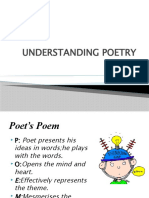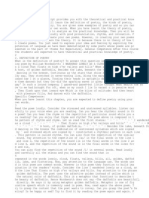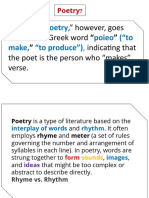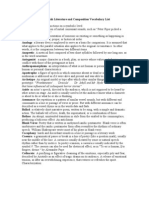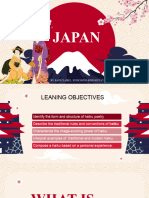Devices That Create Rhythm
Devices That Create Rhythm
Uploaded by
irynCopyright:
Available Formats
Devices That Create Rhythm
Devices That Create Rhythm
Uploaded by
irynOriginal Description:
Original Title
Copyright
Available Formats
Share this document
Did you find this document useful?
Is this content inappropriate?
Copyright:
Available Formats
Devices That Create Rhythm
Devices That Create Rhythm
Uploaded by
irynCopyright:
Available Formats
Poetry can follow a strict structure, or none at all, but many different types of
poems use poetic devices. Poetic devices are tools that a poet can use to
create rhythm, enhance a poem's meaning, or intensify a mood or feeling.
These devices help piece the poem together, much like a hammer and nails
join planks of wood together. Some of these devices are used in literature as
well, but for the sake of clarity, we will look at all of these devices through the
lens of poetry.
Devices That Create Rhythm
Let's start with some of the devices that can be used to create rhythm,
including repetition, syllable variation, and rhyming.
In poetry, repetition is repeating words, phrases, or lines. For example, Edgar
Allen Poe's poem 'The Bells' repeats the word 'bells.' By doing so, Poe creates
a sing-song rhythm similar to that of bells ringing.
To the swinging and the ringing
of the bells, bells, bells--
A unit of poetic meter, also known as a foot, consists of various combinations
of stressed and unstressed syllables. There are several types of feet in poetry,
and they can all be used to create rhythm. One example is an anapest. An
anapest consists of two unaccented syllables with an accented one right
after it, such as com-pre-HEND or in-ter-VENE.
An anapestic meter creates rhythm in Byron's poem 'The Destruction of
Sennacherib.' Read the lines and count out the syllables, noting how every
third syllable is the accented one. Anapestic meter is challenging to craft, but
it creates a powerful rhythmic flow as seen below.
And the sheen of their spears was like stars on the sea,
When the blue wave rolls nightly on deep Galilee.
The reverse of an anapest is a dactyl. It is a stressed syllable followed by two
unstressed ones, such as FLUT-ter-ing or BLACK-ber-ry. Tennyson's poem 'The
Charge of the Light Brigade' uses dactyl meter. As you read the lines, you'll
notice that the poet consistently follows the pattern of one stressed syllable
then two unstressed syllables.
Forward, the Light Brigade!
Half a league, half a league
Rhyming is another common poetic device used to create rhythm. There are
several types of rhyming devices.
One example is a couplet, or two rhymed lines that are together and may or
may not stand alone within a poem. Shakespeare's sonnets end in couplets,
as in his Sonnet 29. Shakespeare's couplet below consists of two lines that
have end rhyme because of the words 'brings' and 'kings.'
For thy sweet love remembered such wealth brings
That then I scorn to change my state with kings.
Another example of rhyming in poetry is internal rhyme, which is a rhyme that
typically occurs within the same line of poetry. Edgar Allen Poe's 'The Raven'
uses internal rhyme with the words 'dreary' and 'weary':
Once upon a midnight dreary, while I pondered, weak and weary
Unlike an internal rhyme, an end rhyme occurs when two words at the end of
lines rhyme. Emily Dickinson's poem 'A Word' uses end rhyme by rhyming the
words 'dead' and 'said' at the end of the lines.
A word is dead
When it is said
Devices That Enhance Meaning
There are many devices that can enhance the meaning of a poem. A simile is
a comparison between two unlike things. Similes use the words 'like' or 'as.' A
simile can get the reader to look at something in a different way. In 'Harlem,'
Langston Hughes compares a dream deferred to a raisin using the word 'like.'
His comparison encourages the reader to look at raisins and dreams
postponed in a new way.
What happens to a dream deferred?
Does it dry up
like a raisin in the sun
In contrast to a simile, a metaphor is a comparison between two unlike things
without using the words like or as. A metaphor uses the senses and compares
two things in a meaningful way. John Donne's poem 'The Sun Rising' uses a
powerful metaphor:
She is all states, and all princes, I.
Through this comparison, Donne is saying that his beloved is richer than all
states, while he is richer than the princes because of their love, and he does
not use 'like' or 'as' in his comparison.
Many poets also use a symbol, or an object that means more than itself and
represents something else. In Robert Frost's poem 'The Road Not Taken,' he
talks about deciding which path to take when coming to a fork in the road.
The fork and the two routes that result symbolize choices in life, a specific
decision that must be made, etc. So, the actual road that he describes
represents something much greater that what it is.
Poets may also use imagery, or words to create an image in the reader's mind.
Imagery is based on our five senses, though visual imagery is used the most.
The images contribute to a poem's meaning. In William Wordsworth's poem 'I
Wandered Lonely as a Cloud,' his emotions build with the images he creates.
Notice how Wordsworth's lines create images in your head because of the
specific details that he uses, thereby creating imagery.
I wandered lonely as a cloud
That floats on high o'er vales and hills,
When all at once I saw a crowd,
A host of golden daffodils;
Devices That Intensify Mood
Some devices are used solely to intensify the mood of the poem. An example
is a hyperbole, an exaggeration that is used for dramatic effect. John Donne
uses hyperbole in his poem 'Song: Go and Catch a Falling Star.'
Ride ten thousand days and nights,
'Til age snow white hairs on thee,
Obviously, ten thousand days and nights might be a bit of an exaggeration (as
is claiming that we'll be white-haired by the time the journey is over), but the
point gets across: a long, long time will pass.
The effect of an alliteration is to add artistic style to a poem or other literary form. ...
An alliteration is the repetition of the same consonant sound that typically occurs at the
beginning of words appearing in a series.
What is the effect of alliteration in poem? A: The effect of an alliteration is to add artistic
style to a poem or other literary form. An alliteration creates a musical quality when reading
or reciting...
You might also like
- Elements of PoetryDocument7 pagesElements of PoetryJoylyn Igloria100% (10)
- Laputa - Castle in the Sky: 君をのせて Main Theme from 天空の城 ラピュタ。Document4 pagesLaputa - Castle in the Sky: 君をのせて Main Theme from 天空の城 ラピュタ。Hoàng Hải100% (1)
- The Winslow BoyDocument1 pageThe Winslow BoyirynNo ratings yet
- Poetic DevicesDocument3 pagesPoetic DevicesJumaryse MarabutNo ratings yet
- Poetic DevicesDocument20 pagesPoetic DevicesAlcides NunezNo ratings yet
- Elements of PoetryDocument7 pagesElements of Poetrymindmover0003No ratings yet
- Poetic DevicesDocument2 pagesPoetic DevicesAdarsh SinghNo ratings yet
- Poetry TermsDocument17 pagesPoetry TermsRoberta RodriguesNo ratings yet
- What Are Poetic DevicesDocument13 pagesWhat Are Poetic Devicestamil selvi100% (1)
- About The Poem - The DaffodilsDocument6 pagesAbout The Poem - The DaffodilsARNAV ARNAVNo ratings yet
- Reading Poetry 2Document9 pagesReading Poetry 2Abhik SarkarNo ratings yet
- Fields of VisionDocument79 pagesFields of Visionandryam7100% (1)
- PoetryDocument48 pagesPoetryangelito peraNo ratings yet
- Introduction To PoetryDocument4 pagesIntroduction To PoetryGreen LightNo ratings yet
- Poetic TechniquesDocument15 pagesPoetic TechniquesVirender SinghNo ratings yet
- LitrDocument3 pagesLitrmrkjhnbrnll11No ratings yet
- Literary Devices Used in A Lyrical BalladDocument8 pagesLiterary Devices Used in A Lyrical BalladPratyasha100% (2)
- The Wonderful World of PoetryDocument66 pagesThe Wonderful World of PoetryaljayNo ratings yet
- DefodillsDocument2 pagesDefodillschandrama singhNo ratings yet
- What Are Poetic DevicesDocument15 pagesWhat Are Poetic DevicesamukrishNo ratings yet
- Presentation By: Rasel AhmedDocument29 pagesPresentation By: Rasel AhmedJade CastilloNo ratings yet
- Poem AnalysisDocument5 pagesPoem AnalysisImee C. CardonaNo ratings yet
- Poetic DevicesDocument42 pagesPoetic Devices7cdsb6ddbnNo ratings yet
- Guide To PoetryDocument14 pagesGuide To PoetryAthul MGNo ratings yet
- Understanding PoetryDocument24 pagesUnderstanding PoetryBhavya SaxenaNo ratings yet
- What Are Sound DevicesDocument9 pagesWhat Are Sound DevicesIve JoyNo ratings yet
- Full of SpeechDocument12 pagesFull of SpeechVan Anh NguyenNo ratings yet
- Understanding PoetryDocument7 pagesUnderstanding Poetryjb99No ratings yet
- Analysis of PoetryDocument64 pagesAnalysis of Poetryroel mabbayad100% (2)
- UntitledDocument13 pagesUntitledAdriansyah KatiliNo ratings yet
- Analysis Poem by Desi Hapsari HamsahDocument3 pagesAnalysis Poem by Desi Hapsari HamsahTasya warouwNo ratings yet
- Line and Rhythm: Jamila and Sebastianus Torino SandriDocument14 pagesLine and Rhythm: Jamila and Sebastianus Torino SandriMilang NoNo ratings yet
- WORKSHEET ON POETIC DEVICES Class 10Document5 pagesWORKSHEET ON POETIC DEVICES Class 10Renu RawatNo ratings yet
- DaffodilsDocument6 pagesDaffodilsShamie LugodNo ratings yet
- PoetryDocument36 pagesPoetryJoanne Ng100% (1)
- The Elements of PoetryDocument52 pagesThe Elements of Poetry陳佐安No ratings yet
- Poetry Background and NotesDocument22 pagesPoetry Background and NotesJamie OrtolanoNo ratings yet
- Fairy - LandDocument6 pagesFairy - LandSubhashini kuramanaNo ratings yet
- Thorough Poetry PPT With Poem Examples 1zsjx59Document40 pagesThorough Poetry PPT With Poem Examples 1zsjx59jasmine man yung chanNo ratings yet
- Literary Techniques Poetry Analysis 2Document33 pagesLiterary Techniques Poetry Analysis 2Azizul KirosakiNo ratings yet
- The Poet: William Wordsworth (1770 - 1850) : William Wordsworth Was Born in Cumberland, England, and AttendedDocument8 pagesThe Poet: William Wordsworth (1770 - 1850) : William Wordsworth Was Born in Cumberland, England, and Attendedsoskahobba100% (1)
- 27 Poetic DevicesDocument10 pages27 Poetic DevicesRajesh SannanNo ratings yet
- Class 10Document4 pagesClass 10Ni Sar Ahmed KakarNo ratings yet
- t2 e 5149 Poetry Terms Powerpoint Ver 4Document28 pagest2 e 5149 Poetry Terms Powerpoint Ver 4Charnelle CoetzeeNo ratings yet
- PoetryDocument22 pagesPoetryHarsh MehtaNo ratings yet
- Poetry 11 TerminologyDocument6 pagesPoetry 11 Terminologyasala123aaupNo ratings yet
- Daffodils Lit DeviceDocument14 pagesDaffodils Lit DeviceSumaiya HakimNo ratings yet
- Critical Appreciation of The Poem DaffodilsDocument5 pagesCritical Appreciation of The Poem Daffodilsbilliboy100% (1)
- Poetry 21Document30 pagesPoetry 21AbirNo ratings yet
- English Literature Notes A Leave TakingDocument10 pagesEnglish Literature Notes A Leave TakingElie aNo ratings yet
- Thorough Poetry PPT With Poem Examples 1zsjx59Document39 pagesThorough Poetry PPT With Poem Examples 1zsjx59Kimberlyn C. SantiagoNo ratings yet
- The S.D Vidya School: Definition and Illustration of 10 Poetic DevicesDocument16 pagesThe S.D Vidya School: Definition and Illustration of 10 Poetic DevicesShubhodeep MandalNo ratings yet
- Mrs. ZELLAT Imene Module: Literature Level: Second Year G: (1, 2, 3, 4, 5, 6)Document7 pagesMrs. ZELLAT Imene Module: Literature Level: Second Year G: (1, 2, 3, 4, 5, 6)Moncif MohamedNo ratings yet
- Daffodils NotesDocument23 pagesDaffodils NotesSarbojeet PoddarNo ratings yet
- I Wandered Lonely As A CloudDocument17 pagesI Wandered Lonely As A CloudYosh QuinNo ratings yet
- Lecture 4 Poetry 1Document27 pagesLecture 4 Poetry 13mptyacc0untyNo ratings yet
- It Took A HurricaneDocument9 pagesIt Took A HurricaneSalva RecheNo ratings yet
- The DaffodilsDocument2 pagesThe DaffodilsRainbow (:No ratings yet
- When Words Collide: A Crash Course in Writing PoetryFrom EverandWhen Words Collide: A Crash Course in Writing PoetryRating: 4 out of 5 stars4/5 (5)
- MM20802Document9 pagesMM20802irynNo ratings yet
- Anthem For Doomed Youth - WILFRED OWENDocument18 pagesAnthem For Doomed Youth - WILFRED OWENirynNo ratings yet
- Marking SchemeDocument3 pagesMarking SchemeirynNo ratings yet
- Journey by Patricia GraceDocument17 pagesJourney by Patricia GraceirynNo ratings yet
- Notes On The StoatDocument5 pagesNotes On The Stoatiryn0% (1)
- Summ & Analysis MPDocument22 pagesSumm & Analysis MPirynNo ratings yet
- Because I Could Not Stop For Death - ExDocument1 pageBecause I Could Not Stop For Death - ExirynNo ratings yet
- The Phoenix - Exam QuestionsDocument3 pagesThe Phoenix - Exam QuestionsirynNo ratings yet
- Identify The Themes. How Did The Writer Present Them in The Story?Document14 pagesIdentify The Themes. How Did The Writer Present Them in The Story?irynNo ratings yet
- SecretsDocument2 pagesSecretsirynNo ratings yet
- Song Tears Idle TearsDocument3 pagesSong Tears Idle TearsirynNo ratings yet
- Meeting at NightDocument9 pagesMeeting at NightirynNo ratings yet
- Praise Song For My MotherDocument9 pagesPraise Song For My MotherirynNo ratings yet
- My Parents - AnalysisDocument6 pagesMy Parents - Analysisiryn100% (1)
- Exam Based Questions - 'To Da-Duh'Document3 pagesExam Based Questions - 'To Da-Duh'irynNo ratings yet
- The Phoenix-Summary AnalysisDocument4 pagesThe Phoenix-Summary AnalysisirynNo ratings yet
- For Heidi With Blue Hair by FleurDocument7 pagesFor Heidi With Blue Hair by Fleuriryn50% (2)
- There Will Come Soft RainsDocument18 pagesThere Will Come Soft Rainsiryn100% (1)
- ReservistDocument4 pagesReservistirynNo ratings yet
- James K. Baxter - Elegy For My Father's FatherDocument8 pagesJames K. Baxter - Elegy For My Father's FatherirynNo ratings yet
- My Parents - Stephen SpenderDocument7 pagesMy Parents - Stephen Spenderiryn100% (2)
- Attack by Siegfried SassoonDocument7 pagesAttack by Siegfried SassoonirynNo ratings yet
- Winslow Boy Study GuideDocument50 pagesWinslow Boy Study Guideiryn67% (3)
- Macbeth NotesDocument87 pagesMacbeth Notesiryn100% (1)
- The Right Thing To Do by Martyn FordDocument17 pagesThe Right Thing To Do by Martyn FordirynNo ratings yet
- Sonnet 144 AssignmentDocument6 pagesSonnet 144 AssignmentMahnoor Ch.No ratings yet
- Swing Low, Sweet ChariotDocument6 pagesSwing Low, Sweet ChariotVexnik Dica AcheaburcanNo ratings yet
- AP English Literature and Composition Vocabulary ListDocument2 pagesAP English Literature and Composition Vocabulary ListKhristian CurryNo ratings yet
- CREATIVE WRITING HandoutsDocument12 pagesCREATIVE WRITING HandoutsRussel AporboNo ratings yet
- Re Shakespearean SonnetDocument8 pagesRe Shakespearean Sonnetapi-534691463No ratings yet
- APlit QuestionsDocument3 pagesAPlit QuestionsVal Hathiramani0% (2)
- Poetry Analysis ChartDocument1 pagePoetry Analysis ChartIago OliveiraNo ratings yet
- Music: First Quarter-Module 4 Rhythmic Patterns in Time Signatures ofDocument19 pagesMusic: First Quarter-Module 4 Rhythmic Patterns in Time Signatures ofjodzmary86No ratings yet
- Concert Piece Soliste001Document2 pagesConcert Piece Soliste001Victor de SousaNo ratings yet
- Conversion and Chart BPM Tempo and Delay To Time and Frequency Calculato RDocument4 pagesConversion and Chart BPM Tempo and Delay To Time and Frequency Calculato RFSL Music100% (1)
- Poem - Figurative Language (Audio)Document19 pagesPoem - Figurative Language (Audio)faruqtsaaqifNo ratings yet
- Abba - Mia Bass in Eb 2Document4 pagesAbba - Mia Bass in Eb 2Nelson Carapinha VazNo ratings yet
- Gaubert MadrigalDocument8 pagesGaubert MadrigalJosé Daniel Galaz Mora100% (2)
- Gossec TambourinDocument4 pagesGossec TambourinLucas DinizNo ratings yet
- OnomatopoeiaDocument14 pagesOnomatopoeiaKit DeoNo ratings yet
- Agua de Beber - Eliane EliasDocument13 pagesAgua de Beber - Eliane EliasRachael HindsNo ratings yet
- 1st Periodical Exam - CreativeDocument4 pages1st Periodical Exam - CreativeJochelle100% (1)
- 1st Q ST# 1 Music 5 FDocument2 pages1st Q ST# 1 Music 5 FRumel TaparanNo ratings yet
- Unit 2 PracticeDocument4 pagesUnit 2 PracticePhuong Thao LeNo ratings yet
- Downbeat Has An Accented Strength and Helps Determine Meter. Thus, When Hearing A Song inDocument1 pageDownbeat Has An Accented Strength and Helps Determine Meter. Thus, When Hearing A Song inJerry Murillo NuñezNo ratings yet
- Alvamar Overture BaritoneDocument4 pagesAlvamar Overture Baritone陳昱豪100% (1)
- Key Poetic Terminology - GCSE (High Ability)Document8 pagesKey Poetic Terminology - GCSE (High Ability)Lezar DemhaNo ratings yet
- Matys - GondelliedDocument5 pagesMatys - GondelliedAlberto GaloppiniNo ratings yet
- Ozymandias - ShelleyDocument28 pagesOzymandias - ShelleyRori noloNo ratings yet
- Accent in Sanskrit - AbhyankarDocument16 pagesAccent in Sanskrit - AbhyankarDeepro ChakrabortyNo ratings yet
- Poetic TechniquesDocument15 pagesPoetic TechniquesVirender SinghNo ratings yet
- IMSLP786802-PMLP1244002-03 Skalkottas - 5 Danzas Griegas (Viola)Document11 pagesIMSLP786802-PMLP1244002-03 Skalkottas - 5 Danzas Griegas (Viola)Junior AlvesNo ratings yet
- HAIKUDocument20 pagesHAIKUkayeclaire0129No ratings yet
- Twinkle Twinkle Little StarDocument2 pagesTwinkle Twinkle Little StarSherilyn NavarroNo ratings yet
























